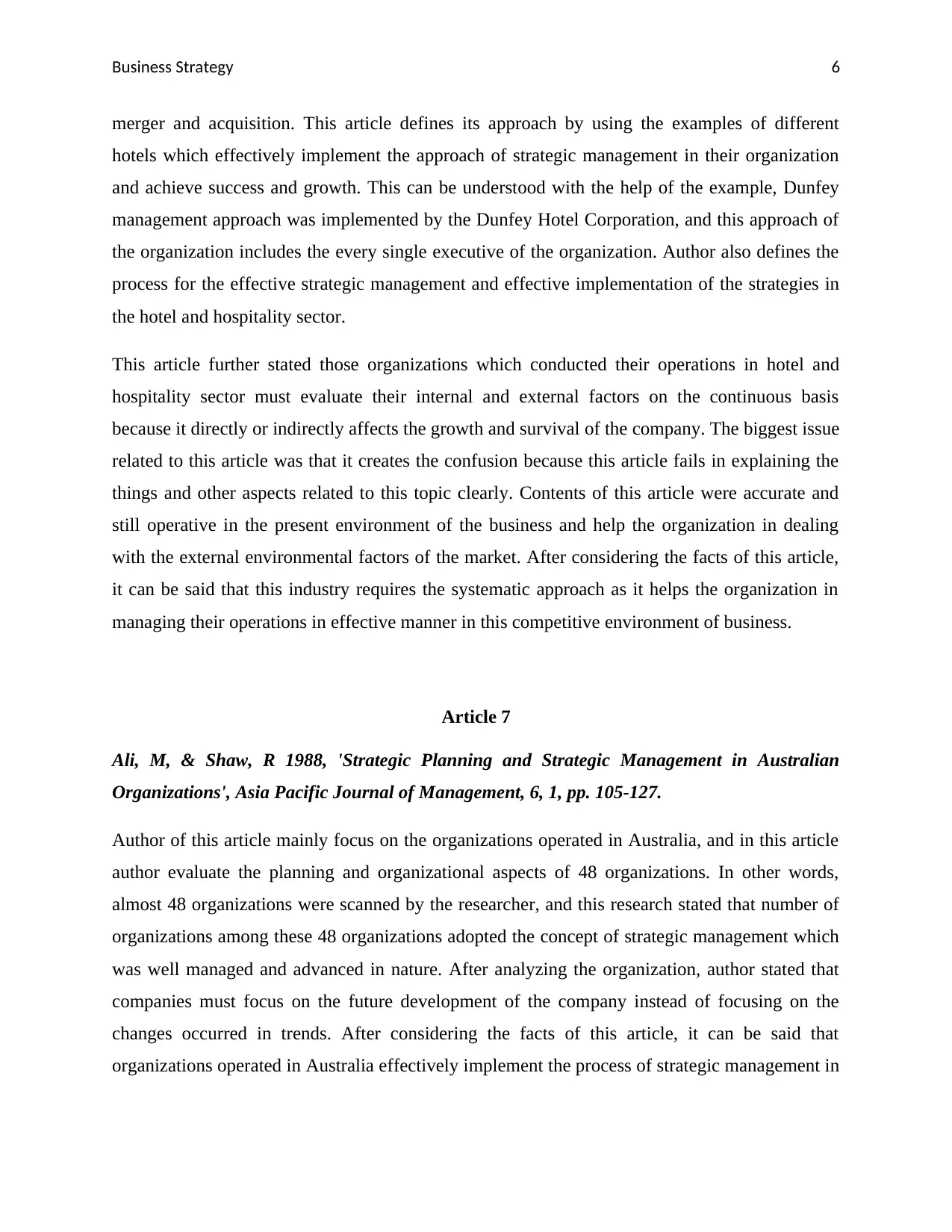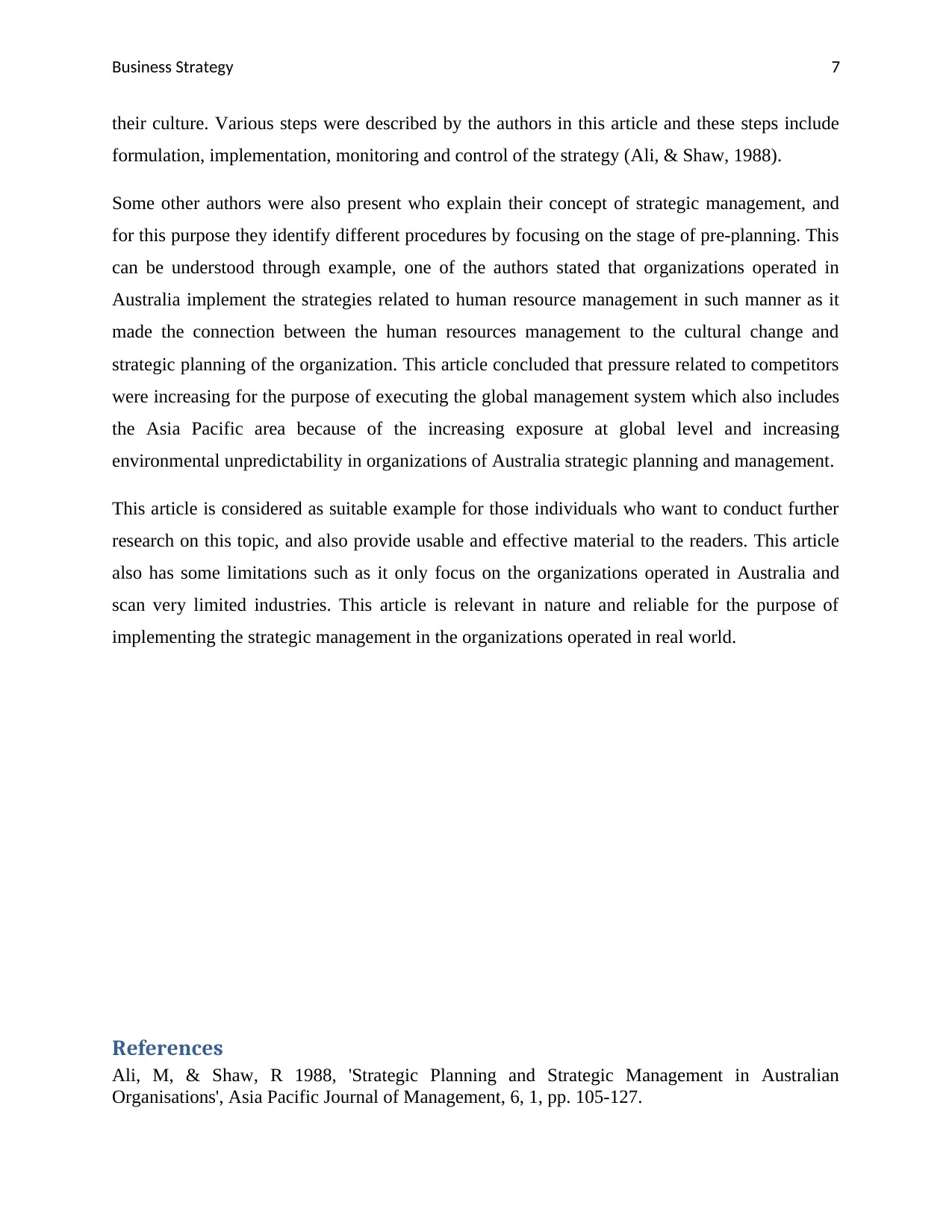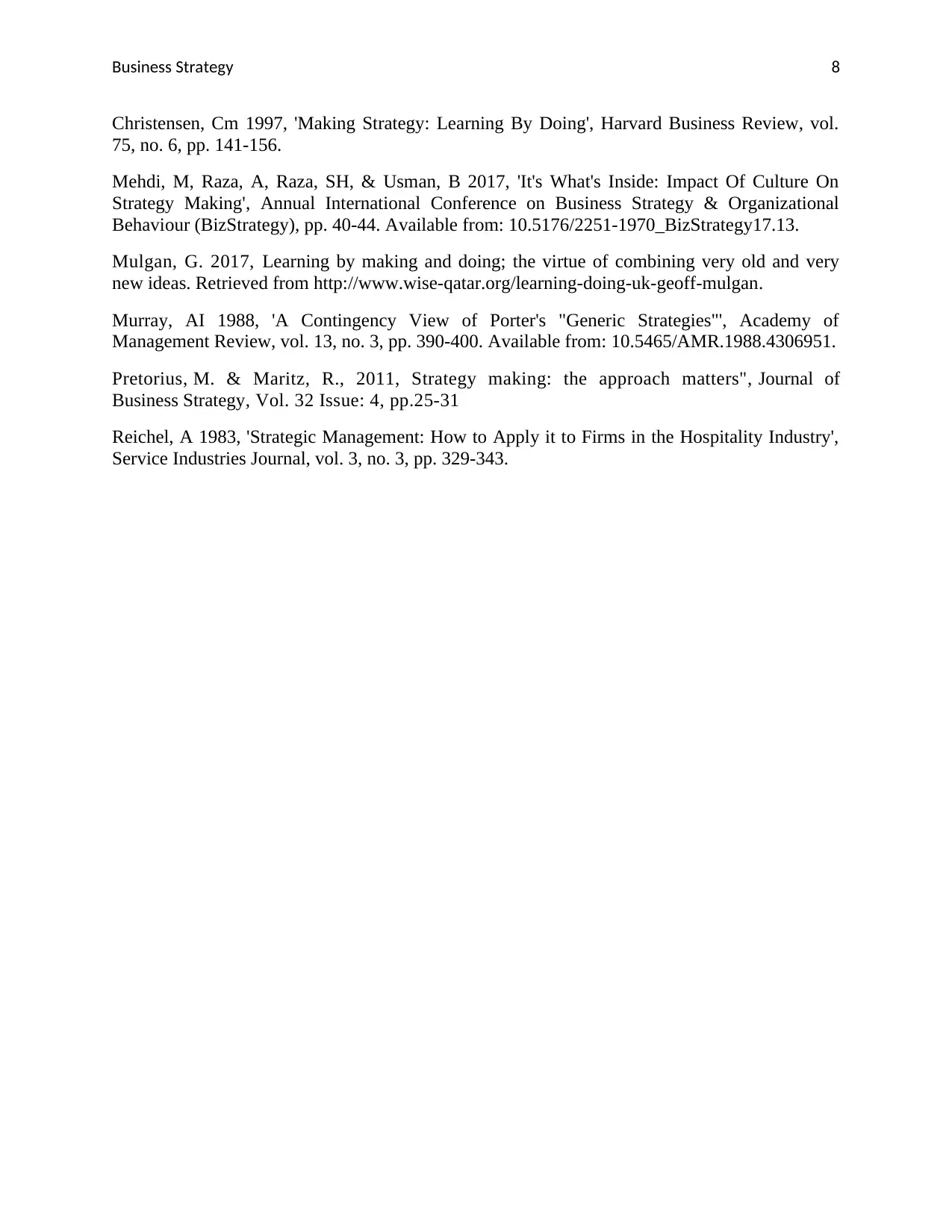Business Strategy: Analysis of Key Articles and Concepts
VerifiedAdded on 2020/05/28
|8
|2465
|179
Report
AI Summary
This report provides an analysis of several articles related to business strategy. The first article discusses Murray's contingency view of Porter's generic strategies, highlighting the importance of strategic implementation and the limitations of applying these strategies concurrently. The second article, by Christensen, explores the challenges organizations face when altering strategies, emphasizing the lack of strategic thinking and the reliance on external consultants. The third article by Mehdi, Raza, and Usman, focuses on the impact of organizational culture on strategy making, stressing the importance of aligning culture with strategic planning for success. Further articles analyze strategic management in the hospitality industry and strategic planning in Australian organizations, discussing the need for continuous evaluation of internal and external factors and the steps involved in strategy formulation, implementation, monitoring, and control. The report concludes by emphasizing the relevance of these articles for understanding and implementing effective business strategies.

Running Head: Business Strategy 1
Business Strategy
Business Strategy
Paraphrase This Document
Need a fresh take? Get an instant paraphrase of this document with our AI Paraphraser

Business Strategy 2
Article 1
Murray, AI 1988, 'A Contingency View of Porter's "Generic Strategies"', Academy of
Management Review, vol. 13, no. 3, pp. 390-400. Available from: 10.5465/AMR.1988.4306951.
In this article Murray mainly focus on the application of contingency approach to the generic
strategies of Porter, and this article defines the importance of the generic strategies in context of
researchers of business policy as it separates the strategic implementation of the companies
which perform well from the companies operated at small level in the same industry. According
to this article, different generic strategies are defined by the porter in context of those companies
which perform well in their industry, and these strategies includes the cost leadership, production
differentiation, etc,.
In this paper, Murray addresses the question whether it was possible to implement these
strategies in concurrent manner on all the companies. Murray states the facts through which
generic strategies of Porter were related with the external requirements. As stated by porter, both
the strategies that were product differentiation and cost leadership can be implemented
concurrently only under the situations which were exceptional in nature. However, article does
not state any way through which these strategies were implemented by the organization. After
analyzing the various strategies of porter, Murray stated that strategies stated by porter were not
exclusive in nature, and each and every strategy can be connected with the diversified strategic
means. Organization can use these strategies for the purpose of attaining the product
differentiation.
By analyzing this article critically, it can be said that concept of generic strategies were
unsatisfactory and confusing, because it fails in defining the process through which these
strategies can be implemented by the organization. In this article, Murray made suggestions that
organization can use the contingency approach for the purpose of removing the weakness and
solving the issues in context of generic concept implementation. Approach used by Murray in
this article states that there was no particular reason because of which organization restrict
themselves to the generic strategies only. Number of studies were developed which describe the
different aspects of the generic strategies and conclusion of one study was completely different
Article 1
Murray, AI 1988, 'A Contingency View of Porter's "Generic Strategies"', Academy of
Management Review, vol. 13, no. 3, pp. 390-400. Available from: 10.5465/AMR.1988.4306951.
In this article Murray mainly focus on the application of contingency approach to the generic
strategies of Porter, and this article defines the importance of the generic strategies in context of
researchers of business policy as it separates the strategic implementation of the companies
which perform well from the companies operated at small level in the same industry. According
to this article, different generic strategies are defined by the porter in context of those companies
which perform well in their industry, and these strategies includes the cost leadership, production
differentiation, etc,.
In this paper, Murray addresses the question whether it was possible to implement these
strategies in concurrent manner on all the companies. Murray states the facts through which
generic strategies of Porter were related with the external requirements. As stated by porter, both
the strategies that were product differentiation and cost leadership can be implemented
concurrently only under the situations which were exceptional in nature. However, article does
not state any way through which these strategies were implemented by the organization. After
analyzing the various strategies of porter, Murray stated that strategies stated by porter were not
exclusive in nature, and each and every strategy can be connected with the diversified strategic
means. Organization can use these strategies for the purpose of attaining the product
differentiation.
By analyzing this article critically, it can be said that concept of generic strategies were
unsatisfactory and confusing, because it fails in defining the process through which these
strategies can be implemented by the organization. In this article, Murray made suggestions that
organization can use the contingency approach for the purpose of removing the weakness and
solving the issues in context of generic concept implementation. Approach used by Murray in
this article states that there was no particular reason because of which organization restrict
themselves to the generic strategies only. Number of studies were developed which describe the
different aspects of the generic strategies and conclusion of one study was completely different

Business Strategy 3
from another study because different approaches were used by these studies for implementing
the strategies.
Article 2
Christensen, CM 1997, 'Making Strategy: Learning by Doing', Harvard Business Review, vol.
75, no. 6, pp. 141-156.
Study directed by Christensen in 1997 named as “'Making Strategy: Learning by Doing” states
that number of reasons were present because of which organizations face difficulties while
altering their strategies. The biggest reason behind this issue was, there were number of
organizations in which manager does not possess the competence of strategic thinking.
Organization hire outsiders for framing the effective strategy for the organization and managers
only have option to implement those strategies and not alter it. In many organizations,
management level does not possess the competence to frame strategies for their organization.
Even, management was not enough competent to make necessary alterations in the strategies of
the organization. In this article Christensen stated that there were number of organizations that
opted for outsourcing in context of strategic planning because they want to increase the
productivity in the organization and decrease the higher cost of the productivity (Christensen,
1997). For this purpose, organization clearly depends on the consultancy agencies which
expertise in the strategic planning and had potential to advice the company related to strategic
planning.
Additionally, this article stated that organizations can employ human resources who possessed
competency in strategic planning so that they can frame and implement rational and innovative
strategies in the organization. Generally, these executives evaluate the strategic position of the
company and make necessary changes in the current strategy of the company by connected their
decisions in strategic planning with the trends of the market and other external and internal
conditions. Further, this article states the challenges faced by the organization while
implementing the process of strategy planning and also provide guidance to the readers of the
article by evaluate the case of manufacturing firm named as Butterfield Fabrics.
from another study because different approaches were used by these studies for implementing
the strategies.
Article 2
Christensen, CM 1997, 'Making Strategy: Learning by Doing', Harvard Business Review, vol.
75, no. 6, pp. 141-156.
Study directed by Christensen in 1997 named as “'Making Strategy: Learning by Doing” states
that number of reasons were present because of which organizations face difficulties while
altering their strategies. The biggest reason behind this issue was, there were number of
organizations in which manager does not possess the competence of strategic thinking.
Organization hire outsiders for framing the effective strategy for the organization and managers
only have option to implement those strategies and not alter it. In many organizations,
management level does not possess the competence to frame strategies for their organization.
Even, management was not enough competent to make necessary alterations in the strategies of
the organization. In this article Christensen stated that there were number of organizations that
opted for outsourcing in context of strategic planning because they want to increase the
productivity in the organization and decrease the higher cost of the productivity (Christensen,
1997). For this purpose, organization clearly depends on the consultancy agencies which
expertise in the strategic planning and had potential to advice the company related to strategic
planning.
Additionally, this article stated that organizations can employ human resources who possessed
competency in strategic planning so that they can frame and implement rational and innovative
strategies in the organization. Generally, these executives evaluate the strategic position of the
company and make necessary changes in the current strategy of the company by connected their
decisions in strategic planning with the trends of the market and other external and internal
conditions. Further, this article states the challenges faced by the organization while
implementing the process of strategy planning and also provide guidance to the readers of the
article by evaluate the case of manufacturing firm named as Butterfield Fabrics.
⊘ This is a preview!⊘
Do you want full access?
Subscribe today to unlock all pages.

Trusted by 1+ million students worldwide

Business Strategy 4
As stated by Mulgan “Learning by making and doing; the virtue of combining very old and very
new ideas". Line stated by Mulgan means that it was necessary for managers in an organization
to learn about the making and implementation of strategy by combining both new and old
techniques and ideas of the organization (Pretorius & Maritz, 2011). After considering the facts
of the article directed by Pretorius and Maritz, it can be said that company must use the
approaches which were effective in nature for the purpose of strategic planning and changing.
Managers must adopt approach of appropriate and best strategy making and also ensure
flexibility of executives in the organization.
Article 3
Mehdi, M, Raza, A, Raza, SH, & Usman, B 2017, 'It's What's Inside: Impact Of Culture On
Strategy Making', Annual International Conference on Business Strategy & Organizational
Behaviour (BizStrategy), pp. 40-44. Available from: 10.5176/2251-1970_BizStrategy17.13.
Mehndi, Raza and Usman direct the article in 2017 and this article named as 'It's What's Inside:
Impact Of Culture On Strategy Making'. This article mainly describes the impact of culture
adopted in the organization on the success, growth, and performance of the organization. This
paper mainly defines the implementation of cultural factors for the purpose of designing the
strategies and techniques of the organization. It also states the huge impact of the culture of the
organization on the strategy making and planning. The main aim of this paper was to define the
cultural framework related to the organization for the purpose of analyzing the data of the given
topic by using the research conducted by various authors on strategy and culture and also for
evaluating the deficiencies related to the chosen topic. However, this paper also states the
example for future researchers (Mehdi, Raza & Usman, 2017).
One more author was there who stated that strategic management and planning must ensure the
innovation related to its competitors, and this innovation was only possible when management
link the culture of the organization with the strategies framed by the organization. This article
states the impact of the corporate culture on the making and implementation of the strategy.
Additionally, author defines that culture of the organization affects the process of the strategic
As stated by Mulgan “Learning by making and doing; the virtue of combining very old and very
new ideas". Line stated by Mulgan means that it was necessary for managers in an organization
to learn about the making and implementation of strategy by combining both new and old
techniques and ideas of the organization (Pretorius & Maritz, 2011). After considering the facts
of the article directed by Pretorius and Maritz, it can be said that company must use the
approaches which were effective in nature for the purpose of strategic planning and changing.
Managers must adopt approach of appropriate and best strategy making and also ensure
flexibility of executives in the organization.
Article 3
Mehdi, M, Raza, A, Raza, SH, & Usman, B 2017, 'It's What's Inside: Impact Of Culture On
Strategy Making', Annual International Conference on Business Strategy & Organizational
Behaviour (BizStrategy), pp. 40-44. Available from: 10.5176/2251-1970_BizStrategy17.13.
Mehndi, Raza and Usman direct the article in 2017 and this article named as 'It's What's Inside:
Impact Of Culture On Strategy Making'. This article mainly describes the impact of culture
adopted in the organization on the success, growth, and performance of the organization. This
paper mainly defines the implementation of cultural factors for the purpose of designing the
strategies and techniques of the organization. It also states the huge impact of the culture of the
organization on the strategy making and planning. The main aim of this paper was to define the
cultural framework related to the organization for the purpose of analyzing the data of the given
topic by using the research conducted by various authors on strategy and culture and also for
evaluating the deficiencies related to the chosen topic. However, this paper also states the
example for future researchers (Mehdi, Raza & Usman, 2017).
One more author was there who stated that strategic management and planning must ensure the
innovation related to its competitors, and this innovation was only possible when management
link the culture of the organization with the strategies framed by the organization. This article
states the impact of the corporate culture on the making and implementation of the strategy.
Additionally, author defines that culture of the organization affects the process of the strategic
Paraphrase This Document
Need a fresh take? Get an instant paraphrase of this document with our AI Paraphraser

Business Strategy 5
planning by changing the informative meanings and schemes assigned by strategists to the
external and internal circumstances of the organization. Therefore, it can be said that this process
is very important for the company’s growth and success. As stated by one author, there are
number of companies which fail because of the ineffective implementation of the strategy
instead of the ineffective formulation of the strategy. After considering the facts stated by this
author, it can be said that implementation of strategy is equal important process as their
formulation (Ahmedi, Salamzadeh, Daraei, & Akbari, 2012).
In this article, very clear provisions and facts were stated by the author for the purpose of
defining the concept, and for increasing the accuracy of the article author use the diagrams and
literature review. This article can be used by future authors for conduct their study. Lastly, it can
be said that culture of the organization play very important role in the strategic planning of the
organization.
Article 6
Reichel, A 1983, 'Strategic Management: How to Apply it to Firms in the Hospitality
Industry', Service Industries Journal, vol. 3, no. 3, pp. 329-343.
In 1983, this article was written by the Reichel, and the main aim of this article was to evaluate
the importance and contribution of the strategic management in the organizations operated their
functions in the hotel and hospitality industry. Hotel and hospitality industry also face high level
competitive aspects like any other industry. Number of aspects was there which required
continuous process which was result oriented in nature not only for the purpose of managing the
organization but also for managing the internal and external environment of the organization by
using the factors such as experience and knowledge which mainly ensure growth, success, and
profitability of the organization.
Strategies used by hospitality sector clearly shows that this industry reaches its maturity stage,
and now it goes towards the trends such as increasing competition, competition in lieu of price
and quality, and share hold by organization in the market. For the purpose of dealing with the
above stated issues, various alternative strategies were adopted by the organization such as
planning by changing the informative meanings and schemes assigned by strategists to the
external and internal circumstances of the organization. Therefore, it can be said that this process
is very important for the company’s growth and success. As stated by one author, there are
number of companies which fail because of the ineffective implementation of the strategy
instead of the ineffective formulation of the strategy. After considering the facts stated by this
author, it can be said that implementation of strategy is equal important process as their
formulation (Ahmedi, Salamzadeh, Daraei, & Akbari, 2012).
In this article, very clear provisions and facts were stated by the author for the purpose of
defining the concept, and for increasing the accuracy of the article author use the diagrams and
literature review. This article can be used by future authors for conduct their study. Lastly, it can
be said that culture of the organization play very important role in the strategic planning of the
organization.
Article 6
Reichel, A 1983, 'Strategic Management: How to Apply it to Firms in the Hospitality
Industry', Service Industries Journal, vol. 3, no. 3, pp. 329-343.
In 1983, this article was written by the Reichel, and the main aim of this article was to evaluate
the importance and contribution of the strategic management in the organizations operated their
functions in the hotel and hospitality industry. Hotel and hospitality industry also face high level
competitive aspects like any other industry. Number of aspects was there which required
continuous process which was result oriented in nature not only for the purpose of managing the
organization but also for managing the internal and external environment of the organization by
using the factors such as experience and knowledge which mainly ensure growth, success, and
profitability of the organization.
Strategies used by hospitality sector clearly shows that this industry reaches its maturity stage,
and now it goes towards the trends such as increasing competition, competition in lieu of price
and quality, and share hold by organization in the market. For the purpose of dealing with the
above stated issues, various alternative strategies were adopted by the organization such as

Business Strategy 6
merger and acquisition. This article defines its approach by using the examples of different
hotels which effectively implement the approach of strategic management in their organization
and achieve success and growth. This can be understood with the help of the example, Dunfey
management approach was implemented by the Dunfey Hotel Corporation, and this approach of
the organization includes the every single executive of the organization. Author also defines the
process for the effective strategic management and effective implementation of the strategies in
the hotel and hospitality sector.
This article further stated those organizations which conducted their operations in hotel and
hospitality sector must evaluate their internal and external factors on the continuous basis
because it directly or indirectly affects the growth and survival of the company. The biggest issue
related to this article was that it creates the confusion because this article fails in explaining the
things and other aspects related to this topic clearly. Contents of this article were accurate and
still operative in the present environment of the business and help the organization in dealing
with the external environmental factors of the market. After considering the facts of this article,
it can be said that this industry requires the systematic approach as it helps the organization in
managing their operations in effective manner in this competitive environment of business.
Article 7
Ali, M, & Shaw, R 1988, 'Strategic Planning and Strategic Management in Australian
Organizations', Asia Pacific Journal of Management, 6, 1, pp. 105-127.
Author of this article mainly focus on the organizations operated in Australia, and in this article
author evaluate the planning and organizational aspects of 48 organizations. In other words,
almost 48 organizations were scanned by the researcher, and this research stated that number of
organizations among these 48 organizations adopted the concept of strategic management which
was well managed and advanced in nature. After analyzing the organization, author stated that
companies must focus on the future development of the company instead of focusing on the
changes occurred in trends. After considering the facts of this article, it can be said that
organizations operated in Australia effectively implement the process of strategic management in
merger and acquisition. This article defines its approach by using the examples of different
hotels which effectively implement the approach of strategic management in their organization
and achieve success and growth. This can be understood with the help of the example, Dunfey
management approach was implemented by the Dunfey Hotel Corporation, and this approach of
the organization includes the every single executive of the organization. Author also defines the
process for the effective strategic management and effective implementation of the strategies in
the hotel and hospitality sector.
This article further stated those organizations which conducted their operations in hotel and
hospitality sector must evaluate their internal and external factors on the continuous basis
because it directly or indirectly affects the growth and survival of the company. The biggest issue
related to this article was that it creates the confusion because this article fails in explaining the
things and other aspects related to this topic clearly. Contents of this article were accurate and
still operative in the present environment of the business and help the organization in dealing
with the external environmental factors of the market. After considering the facts of this article,
it can be said that this industry requires the systematic approach as it helps the organization in
managing their operations in effective manner in this competitive environment of business.
Article 7
Ali, M, & Shaw, R 1988, 'Strategic Planning and Strategic Management in Australian
Organizations', Asia Pacific Journal of Management, 6, 1, pp. 105-127.
Author of this article mainly focus on the organizations operated in Australia, and in this article
author evaluate the planning and organizational aspects of 48 organizations. In other words,
almost 48 organizations were scanned by the researcher, and this research stated that number of
organizations among these 48 organizations adopted the concept of strategic management which
was well managed and advanced in nature. After analyzing the organization, author stated that
companies must focus on the future development of the company instead of focusing on the
changes occurred in trends. After considering the facts of this article, it can be said that
organizations operated in Australia effectively implement the process of strategic management in
⊘ This is a preview!⊘
Do you want full access?
Subscribe today to unlock all pages.

Trusted by 1+ million students worldwide

Business Strategy 7
their culture. Various steps were described by the authors in this article and these steps include
formulation, implementation, monitoring and control of the strategy (Ali, & Shaw, 1988).
Some other authors were also present who explain their concept of strategic management, and
for this purpose they identify different procedures by focusing on the stage of pre-planning. This
can be understood through example, one of the authors stated that organizations operated in
Australia implement the strategies related to human resource management in such manner as it
made the connection between the human resources management to the cultural change and
strategic planning of the organization. This article concluded that pressure related to competitors
were increasing for the purpose of executing the global management system which also includes
the Asia Pacific area because of the increasing exposure at global level and increasing
environmental unpredictability in organizations of Australia strategic planning and management.
This article is considered as suitable example for those individuals who want to conduct further
research on this topic, and also provide usable and effective material to the readers. This article
also has some limitations such as it only focus on the organizations operated in Australia and
scan very limited industries. This article is relevant in nature and reliable for the purpose of
implementing the strategic management in the organizations operated in real world.
References
Ali, M, & Shaw, R 1988, 'Strategic Planning and Strategic Management in Australian
Organisations', Asia Pacific Journal of Management, 6, 1, pp. 105-127.
their culture. Various steps were described by the authors in this article and these steps include
formulation, implementation, monitoring and control of the strategy (Ali, & Shaw, 1988).
Some other authors were also present who explain their concept of strategic management, and
for this purpose they identify different procedures by focusing on the stage of pre-planning. This
can be understood through example, one of the authors stated that organizations operated in
Australia implement the strategies related to human resource management in such manner as it
made the connection between the human resources management to the cultural change and
strategic planning of the organization. This article concluded that pressure related to competitors
were increasing for the purpose of executing the global management system which also includes
the Asia Pacific area because of the increasing exposure at global level and increasing
environmental unpredictability in organizations of Australia strategic planning and management.
This article is considered as suitable example for those individuals who want to conduct further
research on this topic, and also provide usable and effective material to the readers. This article
also has some limitations such as it only focus on the organizations operated in Australia and
scan very limited industries. This article is relevant in nature and reliable for the purpose of
implementing the strategic management in the organizations operated in real world.
References
Ali, M, & Shaw, R 1988, 'Strategic Planning and Strategic Management in Australian
Organisations', Asia Pacific Journal of Management, 6, 1, pp. 105-127.
Paraphrase This Document
Need a fresh take? Get an instant paraphrase of this document with our AI Paraphraser

Business Strategy 8
Christensen, Cm 1997, 'Making Strategy: Learning By Doing', Harvard Business Review, vol.
75, no. 6, pp. 141-156.
Mehdi, M, Raza, A, Raza, SH, & Usman, B 2017, 'It's What's Inside: Impact Of Culture On
Strategy Making', Annual International Conference on Business Strategy & Organizational
Behaviour (BizStrategy), pp. 40-44. Available from: 10.5176/2251-1970_BizStrategy17.13.
Mulgan, G. 2017, Learning by making and doing; the virtue of combining very old and very
new ideas. Retrieved from http://www.wise-qatar.org/learning-doing-uk-geoff-mulgan.
Murray, AI 1988, 'A Contingency View of Porter's "Generic Strategies"', Academy of
Management Review, vol. 13, no. 3, pp. 390-400. Available from: 10.5465/AMR.1988.4306951.
Pretorius, M. & Maritz, R., 2011, Strategy making: the approach matters", Journal of
Business Strategy, Vol. 32 Issue: 4, pp.25-31
Reichel, A 1983, 'Strategic Management: How to Apply it to Firms in the Hospitality Industry',
Service Industries Journal, vol. 3, no. 3, pp. 329-343.
Christensen, Cm 1997, 'Making Strategy: Learning By Doing', Harvard Business Review, vol.
75, no. 6, pp. 141-156.
Mehdi, M, Raza, A, Raza, SH, & Usman, B 2017, 'It's What's Inside: Impact Of Culture On
Strategy Making', Annual International Conference on Business Strategy & Organizational
Behaviour (BizStrategy), pp. 40-44. Available from: 10.5176/2251-1970_BizStrategy17.13.
Mulgan, G. 2017, Learning by making and doing; the virtue of combining very old and very
new ideas. Retrieved from http://www.wise-qatar.org/learning-doing-uk-geoff-mulgan.
Murray, AI 1988, 'A Contingency View of Porter's "Generic Strategies"', Academy of
Management Review, vol. 13, no. 3, pp. 390-400. Available from: 10.5465/AMR.1988.4306951.
Pretorius, M. & Maritz, R., 2011, Strategy making: the approach matters", Journal of
Business Strategy, Vol. 32 Issue: 4, pp.25-31
Reichel, A 1983, 'Strategic Management: How to Apply it to Firms in the Hospitality Industry',
Service Industries Journal, vol. 3, no. 3, pp. 329-343.
1 out of 8
Related Documents
Your All-in-One AI-Powered Toolkit for Academic Success.
+13062052269
info@desklib.com
Available 24*7 on WhatsApp / Email
![[object Object]](/_next/static/media/star-bottom.7253800d.svg)
Unlock your academic potential
Copyright © 2020–2025 A2Z Services. All Rights Reserved. Developed and managed by ZUCOL.




